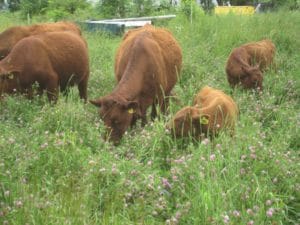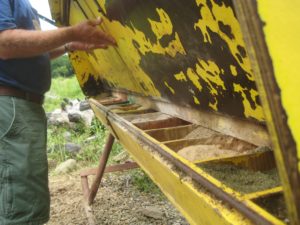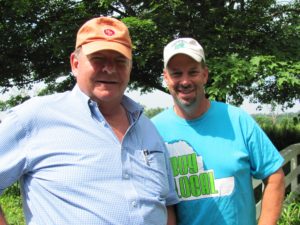True Capital is Biological Capital
3 Days of Inspiration from a South African Rancher
When a farmer whose family lineage on the same land dates back to 1863 speaks about taking back our own destiny from the very people who keep us in fossil fuel/ low price farming bondage and advocates for spending more time watching your kids, animals and the checkbook, I sit up and pay attention. The statement, “Making a profit is not a swear word”, and other very colorful sound-bites by Ian Mitchell-Innes, a PH paper wielding, South African rancher and Certified Holistic Management Educator made for an inspiring planned grazing training.

Rotokawa Beef Cattle Company was the gathering place for 30 farmers from the Northeast, Texas and Canada to learn about grazing principles and holistic decision-making. Photo by Troy Bishopp
He eloquently brought to light the fact that we are in the energy regeneration business—human, solar, and soil carbon energy. “It’s about using decision-making with two future generations in mind and a positive attitude in working with nature to capture this energy flow through our own biological power plants right at home”, said the man who grazes 5000 head of cattle on 14,000 brittle acres and grows more grass than he can use by trampling in the leftovers for his microbial friends.
The Rotokawa Beef Cattle Company was the gathering place for 30 farmers from the Northeast, Texas and Canada to learn about the principles of mob grazing, ultra high stock densities, holistic decision-making and financial planning over 3 days in the rugged hills of Hardwick, Massachusetts. Mr. “Litter” made it quite clear that every farm should develop a holistic goal and use it to plan the future you want to create before adopting any grazing strategy. He was adamant about not giving any blanket grazing recipes for participants who have not discovered this thought process.
He talked extensively about the energy in-energy out, money in-money out dynamic of generating triple bottom line wealth derived from using animal power to capture solar dollars from pasture plants. He wished more farmers would just sit and watch their animals graze. “You can learn everything you need to know about soil and animal health from observing their grazing habits”, said Ian. We took this suggestion literally as we proceeded out to the field to see the mob of Rotokawa cows, calves and bulls.
What I intimately witnessed was an affirmation or (gut check) of my life-long journey to understand the nuances of forage height, plant diversity and grazing management. The classroom prophecy came to fruition when the herd was moved to a new paddock. The cows immediately nipped off the seed-heads and flowers followed by tearing at leaves on the way down into the tall canopy relishing the clovers and young forbs at the bottom of the sward. Ian explained the cow’s need for concentrated energy in the seed to balance the protein content in the legumes. By using PH paper dunked in the urine, Ian demonstrated this equilibrium by showing farmers a near neutral rumen ph. “Give your animals a smorgasbord and let them decide their own diet”, said the grazing master.

Ian advocates for a cafeteria style mineral program containing at least 12 separate ingredients mixed with sea salt. Photo by Troy Bishopp
Heads turned quickly when the grazing guru said we should be allowing our cows to selectively graze twenty percent of the sward whereby maximizing animal performance, and trampling the rest into the soil substrate for our biological livestock. Questions and conversations about WASTING grass circled the rancher to which he held steadfast to his belief, “There is no such thing as wasted grass. You’ll make more money turning litter into an active, healthy microbial soil growing more forage and drought-proofing your farm than selling beef”.
I was pleased to condition my grazier’s eye to what constituted an 80, 50 and 20 percent trample. I also bantered the grass king about bush-hogging and getting the paddock chopped up and back to a vegetative state. This brought Ian to say, “Who cares, and was it part of my holistic goal? You must gauge the energy in-energy out advantage of your decision to spend valuable time, equipment and fuel to cut grass. Maybe you should change your management, animal densities or add cow numbers to take care of your need for conformity. Mother Nature likes her land to be a mosaic of heights for all species, and not just for your cows”. “Ok already, I’ll study my decision to mow more closely”, I said.
The idea of mob stocking and ultra-high stock densities grazing tall paddocks is to invigorate the microscopic biologists, dung beetles and create species diversity. “The paradigm of consistently grazing short to capture a vegetative, high protein leaf messes up the rumen ph and will take you on a path to simple plant mixtures, but a more mature stand will grow stronger, deeper, root systems with a variety of plant heights that will give you nutritional balance. Form will follow function because Mother Nature likes diversity”, said Ian. He encouraged the group to experiment this concept on a small patch within a field and judge for yourself. Of course he reiterated it was still the holistic farm goal that would guide the decision to implement this grazing management tool.
To complement the salad bar, Ian advocates for a cafeteria style mineral program containing at least 12 separate ingredients mixed with sea salt. Cattle owner, Ridge Shinn, has taken this advice to heart by providing minerals in a specialized feeder, both developed by the Helfter Feeds Company. “It’s the only recipe I could get out of Ian”, joked Ridge.
In addition to all this great hands-on learning were sessions on grazing and financial planning. Imagine planning out your grazing system before the season starts. Ian touched on the importance of biological monitoring your paddocks to measure the progress of your management towards the holistic goal. The financial piece was to budget in your profit and income first – then work on the expenses from what was left. I thought, pay yourself first, how novel. He focused us in on generating wealth from how we reinvested the money earned instead of the things we sold and reducing risk by looking at your financial weak links. The chains of production to look at are: resource conversion, product conversion and marketing conversion. My weakness seems to lie within all three.
My mind wandered back to my own operation. Was I converting all the grass into wealth? No. Could I convert some equipment into a wealth generating expense? Yes. Do I measure and monitor my progress towards a holistic goal? Sometimes. Do I need to get a handle on my time management? Absolutely. Do I have peace of mind and quality time for my family? I’m working hard towards this goal.
Driving home with a head full of knowledge to initiate change towards a better future for my family and the environment can be a little unsettling. Changes must be toward a vision or goal and not just be willy-nilly random acts. I have learned over the years that changing our mindset is a process influenced by many outside forces, all of which are not positive, so hang in there. I sleep better at night knowing a farmer taught me about the value of true capital, and it was right under my feet and shining on my thinning scalp.


